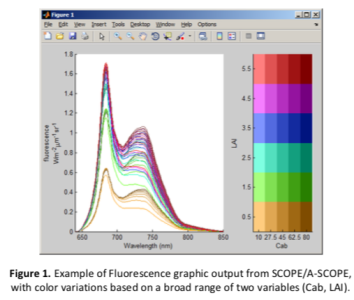FLEX/SENTINEL-3 TANDEM MISSION PHOTOSYNTHESIS STUDY

Chlorophyll fluorescence (CF) is a natural spectral emission resulting from the interaction of plant chlorophyll pigment with visible light (typically 400‐700 nm). In photosynthesizing tissues, red and far‐red light can be emitted from any chlorophyll‐containing plant tissues which are exposed to light: primarily foliage, but also green stems, green exposed roots, floral structures, many fruits, and green seeds. This emission of chlorophyll fluorescence caused by sunlight is termed ‘solar‐induced’ or ‘sun‐induced’ fluorescence (SIF), and its measurement technique is deemed to be passive as no artificial excitation light is used to induce the fluorescence.
The capacity to observe SIF presents a totally novel option for space‐based remote sensing: extracting information on the actual workings of the photosynthetic machinery of plant canopies. Because the production of chlorophyll fluorescence is related to the function of the two photosystems responsible for photosynthetic initiation in green plants, it provides a glimpse into the dynamics of the photosynthetic process itself, an insight not available from existing methodologies involving the usual vegetation reflectance indices.
Momentum is building within the scientific community to apply SIF to quantify terrestrial vegetation photosynthesis – including for the modelling of gross primary productivity (GPP). A second major application area is in detection of stress effects, especially before visual damage is apparent. Stress applications do not necessarily require quantification of photosynthetic rates or GPP, but instead may be able to utilize simple SIF indices.
Promising results in recent years from other investigators indicate that it is indeed possible to discriminate the subtle SIF signal from satellite platforms; however, existing satellite sensors are not optimized spatially or spectrally for SIF retrievals and applications. This presents a unique advantage for the FLuorescence EXplorer (FLEX), which is being designed specifically for the purpose of capture and usage of SIF from terrestrial vegetation. Key to that initiative is the development of methods to derive quantitative photosynthetic information from SIF.
